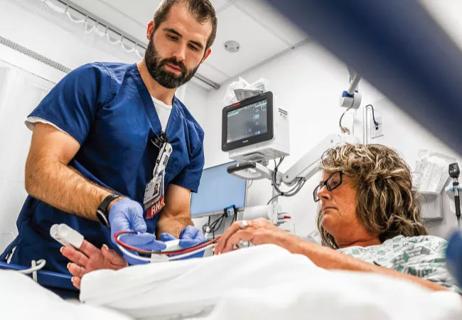Caregiver collaboration and patient education remain critical

A new study found that the incidence of emergency department (ED) visits for alcohol-associated hepatitis (AH) increased annually prior to the COVID-19 pandemic. Additionally, the data revealed that patients who presented to the ED with this condition were younger and had more severe illness with the majority having co-existing cirrhosis or complications of portal hypertension.
Advertisement
Cleveland Clinic is a non-profit academic medical center. Advertising on our site helps support our mission. We do not endorse non-Cleveland Clinic products or services. Policy
This research, “Emergency Services Utilization by Patients with Alcohol-Associated Hepatitis: An Analysis of National Trends,” was recently presented by study author Shreya Sengupta, MD, Department of Gastroenterology, Hepatology & Nutrition at Cleveland Clinic during the American Association for the Study of Liver Diseases conference.
Alcohol-associated hepatitis — the most severe form of alcohol-associated liver disease (ALD) — accounts for 0.83% of all hospital admissions in the United States, according to Dr. Sengupta and colleagues, who initiated the current study to better understand the burden of ALD.
Their analysis examined the rates, characteristics, and outcomes of patients who present to the ED for alcohol-associated hepatitis. Between January 1, 2016 and December 31, 2019, discharge data from the Nationwide Emergency Department Sample was used to analyze ED visits for adult patients.
“If the principal diagnosis during the ED visit was alcohol-associated hepatitis, this visit was classified as primary AH,” Dr. Sengupta explains. “Secondary AH was defined if alcohol-associated hepatitis was co-listed with a principal diagnosis. We analyzed the numbers of patients evaluated, the severity of disease, complications of liver disease and discharge disposition.”
Data showed that there were 466,014,370 ED visits from 2016 to 2019. Of those, 448,984 (0.096%) were for alcohol-associated hepatitis. The majority of ED visits (80.6%) were for secondary AH, according to Dr. Sengupta and colleagues, who noted that 85.9 percent had a primary diagnosis closely linked to alcohol-associated hepatitis, which suggests that AH was the main reason for ED utilization.
Advertisement
Sixty-six percent of patients in this study were male and the mean age was 47 years. The study authors found that ED visits for this condition were most common among individuals between the ages of 45 and 64 years (50.9%) followed by those aged 25 to 44 years old (40.8%).
Dr. Sengupta and colleagues observed that younger patients were more likely to present with primary alcohol-associated hepatitis while their older counterparts were more likely to have secondary AH.
Cirrhosis (62.5%), ascites (24.5%) and acute kidney injury (17.4%) were the most common complications of liver disease, and all of these complications increased throughout the study period, reports Dr. Sengupta. “Although the total number of ED visits did not change over the study period, the overall crude rate of AH increased from 85 to 106 per 100,000 ED visits.”
When discussing why younger patients with AH may present to the ED more often than older individuals, Dr. Sengupta highlights a few possibilities that could account for this trend. “It may be that rates of binge drinking are higher in younger patients,” she suggests, while also noting a lack of knowledge regarding binge drinking and associated risks. “There are misperceptions that beer isn’t as bad as wine or liquor which could also be a contributing factor.”
Other potential explanations, according to Dr. Sengupta, include increasing rates of metabolic dysfunction-associated liver disease, previously known as non-alcoholic fatty liver disease, among younger individuals as well as higher rates of hepatitis C infection over the last few years, a consequence of the opioid epidemic. “I believe all of these factors together could increase the risk of acute injury in younger patients and may not be present in the older patient population.”
Advertisement
These findings shed further light on the burden of this disease and its impact on healthcare utilization, particularly the emergency department. Given the progressive increase in ED visits for alcohol-associated hepatitis, Dr. Sengupta and colleagues emphasize the importance of screening for alcohol use disorders in the primary care setting to ensure early diagnosis before severe illness requires emergent care.
“There is a significant burden on emergency department physicians, and, in many cases, they also provide a lot of primary care,” says Dr. Sengupta. “It is important to recognize that patients are presenting to the ED with alcohol-associated hepatitis and develop interventions that can be implemented in this setting. We must also find ways to better plan for outpatient access for these patients so that they don’t have to seek care in the ED.”
When asked how these findings could affect patient care at Cleveland Clinic, Dr. Sengupta notes, “While this study won’t necessarily change screening guidelines in an ambulatory setting, it can lead to collaborations and conversations with our emergency department colleagues. Is there an intervention that can be used in the ED? Should an automatic referral be triggered? Can we incorporate a community health outreach component?”
“There are several interesting questions that we could discuss with our emergency department colleagues to optimize healthcare utilization while also improving care for our patients with alcohol-associated hepatitis,” she concluded.
Advertisement
Dr. Sengupta also highlights the presence of the Multidisciplinary Alcohol-Associated Liver Disease Program (MAP Clinic) at Cleveland Clinic, of which she is the Medical Director. “Our multidisciplinary program allows us to take a truly holistic approach with how we treat our patients. There are so many factors to consider and being able to coordinate care with clinicians who have expertise in various specialties allows us to really tailor our care. The program has been around for about two years, and we have treated more than 100 patients.”
Advertisement
Advertisement

Findings show no increased risk in long-term outcomes

Researchers explore how changes in the gut microbiome influence the brain's reward response to alcohol

Addiction experts use decades of research and clinical experience to help patients overcome substance use disorders

This technical solution expedites the patient’s ED to admissions process

Akron General and Union Hospital increase throughput and patient satisfaction by rethinking their approach to care

Structured data helps identify older adults at risk for poor outcomes, defines patients who require more comprehensive assessments

Specialized unit provides patients with faster, more targeted care

Remotely based physicians use telehealth technology to evaluate lower-acuity patients in the ED, express clinic or during an EMS response